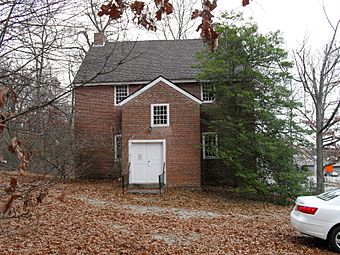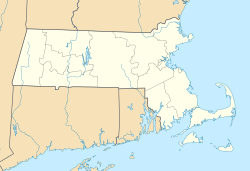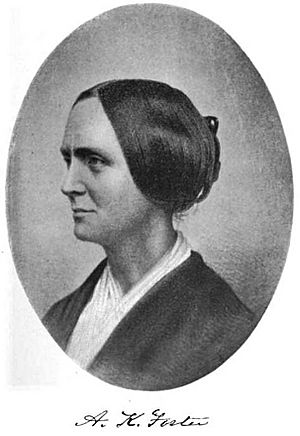Friends Meetinghouse (Uxbridge, Massachusetts) facts for kids
Quick facts for kids |
|
|
Friends Meetinghouse
|
|

Friends Meeting House, Uxbridge, MA, 1770, Route 146A and Route 98; National Register of Historic Places
|
|
| Nearest city | Uxbridge, Massachusetts |
|---|---|
| Area | 2 acres (0.81 ha) |
| Built | 1770 |
| NRHP reference No. | 74000395 |
| Added to NRHP | January 24, 1974 |
The Friends Meetinghouse is a very old and important building in Uxbridge, Massachusetts. It's a special church for the Quakers, a religious group known for peace and equality. This historic building was added to the National Register of Historic Places on January 24, 1974. This means it's recognized as a significant part of American history.
Contents
History of the Meetinghouse
Building the Quaker Church
The Friends Meetinghouse was built in 1770 in Uxbridge, Massachusetts. It was constructed by Quakers who had moved from Smithfield, Rhode Island. The building stands on what was once the farm of Moses Farnum. The bricks used to build it were made right across the street.
This meetinghouse is special because it's one of the few old churches made of rough bricks still standing in America. It has two stories and a balcony inside. Following Quaker traditions, the building had separate entrances and meeting areas for men and women.
Quakers in Massachusetts
The area where the meetinghouse was built was known as "Quaker City." This settlement was one of the first places where Quakers moved back into the Massachusetts Colony. This happened after they had been forced out by the Puritans in the 1600s. The Friends Meetinghouse is a brick, two-story building with a rectangular roof. You can find it at 479 Quaker Highway.
Important People and the Anti-Slavery Movement
Rhode Island Quakers and Early Industry
Quakers and other people from Rhode Island and Massachusetts still help take care of this historic building. The Mowry family from Rhode Island were among the first members of this church. Richard Mowry was an important Quaker who lived in Quaker City. He invented machines to make wool and cotton. This made him a pioneer in America's early industrial revolution. He was a very religious Quaker who traveled widely to share his beliefs.
Abby Kelley Foster: A Champion for Freedom
This historic church was also the spiritual home of Abby Kelley Foster. She was a strong voice against slavery, known as an "abolitionist." She inspired famous leaders like Susan B. Anthony and Lucy Stone to join the movement to end slavery. In 1841, the Uxbridge Quaker Meeting decided to no longer recognize her as a member. This was because she gave powerful speeches against slavery to audiences that included both men and women, which was considered too radical at the time.
Effingham Capron and the Underground Railroad
Another nationally known anti-slavery leader, Effingham Capron, belonged to the Uxbridge meeting. He was a passionate advocate against slavery. He led the anti-slavery movement in Uxbridge, which had about 450 local members. He also served as a vice president for state and national anti-slavery groups.
Effingham invited important leaders to speak in Uxbridge in the 1830s. He was famous for his anti-slavery work and for helping enslaved people escape to freedom. He did this by housing them on the Underground Railroad. Effingham owned the local Capron mill. Uxbridge was a key stopping point for enslaved people traveling north. They used the canal path and later the railroad, along with a main road from Connecticut. They were heading to free African communities in the Blackstone Valley and Worcester. The Worcester area was a center for the anti-slavery movement, and the Quaker Meetinghouse was a vital part of this network.
Early Quakers and Slavery
The first Quakers who settled here from Smithfield and Providence, Rhode Island, were among the first people in America to personally reject slavery. They also freed the enslaved people they owned. These early Quakers were connected to the religious group of Moses Brown, who helped start Brown University.
There are many Quaker homes built in this area. It was known by several names, including Quaker City, Aldrich Village, and the village of Ironstone, Massachusetts. The cemetery at the meetinghouse is also full of history. Church records from Uxbridge mention the death of various members of the Arnold family. For example, "Sarah Arnold," who was the widow of Benedict, died at age 83 on February 14, 1836. It was once thought that Peggy Shippen, the second wife of General Benedict Arnold (a famous general from the Revolutionary War who became a traitor), returned to Uxbridge secretly after being in England. She may have come back to her Quaker roots at this Friends Meetinghouse. She was raised as a Quaker in Philadelphia.
A cemetery for a poorhouse nearby was moved when Route 146 was built between 1981 and 1984. This led to interesting historical discoveries by researchers from Boston University.
See also




